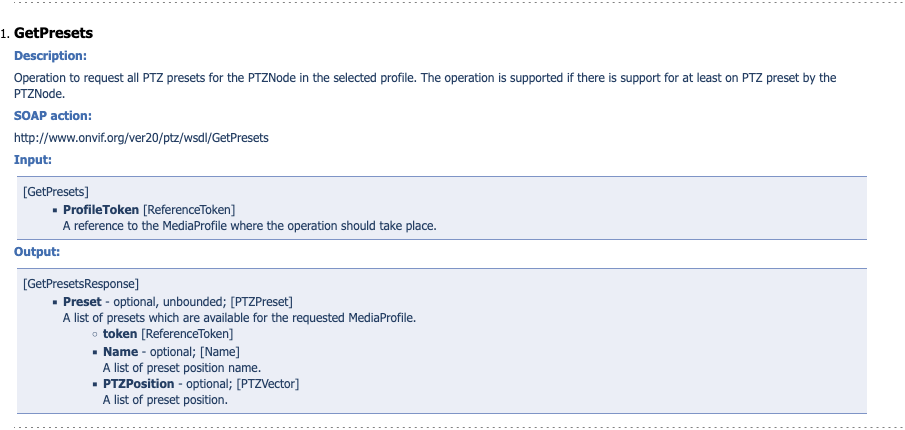扩展ExOnvif 调用指定预置位GotoPreset请参考此文章。
在使用 Elixir 进行 IPdome 控制时,可以使用 ExOnvif 库。
ExOnvif官方文档中未给出预置位调用命令,自己按照onvif协议 Onvif协议 扩展的此项功能;
Onvif协议获取预置位内容:

由以上协议可以看出,获取摄像机所有预置位,只需要一个参数 profile_token,返回值为:此摄像机已设置的所有预置位
步骤如下:
- 初始化device设备
- 获取device的profile_token
- 获取设备的预置位表
- 将返回值格式化
# 初始化device设备
defp get_device(uri) when not is_nil(uri) do
%{host: host, userinfo: userinfo} = URI.parse(uri)
[user, pw] = String.split(userinfo, ":")
Device.new("http://" <> host, user, pw);
end
defp get_device(uri) do
:error
end
# 获取设备的 main stream 的profile_token
defp get_main_stream_profile_token(device) do
profiles = Media2.get_profiles(device)
case profiles do
{:ok, list} -> {:ok, hd(list).reference_token}
_ -> "something went wrong"
end
end
# 获取设备所有的预置位
defp get_presets(device, profile_token) do
body = element("tptz:GetPresets", element("tptz:ProfileToken", profile_token))
ptz_request(device, "GetPresets", body, fn _ -> :ok end)
end
注意:提前导入需要的模块
完整文件onvif.action.ex文件
defmodule Onvif.Action do
@moduledoc """
自定义的Onvif的部分协议
获取当前状态(exonvif)
absolute move调用摄像头到指定位置,
continuous move摄像头连续移动
调用指定预置位
停止运动
"""
alias ExOnvif.Device
alias ExOnvif.Media2
import ExOnvif.Utils.ApiClient, only: [ptz_request: 4]
defp get_device(uri) when not is_nil(uri) do
%{host: host, userinfo: userinfo} = URI.parse(uri)
[user, pw] = String.split(userinfo, ":")
Device.new("http://" <> host, user, pw);
end
defp get_device(uri) do
:error
end
defp get_main_stream_profile_token(device) do
profiles = Media2.get_profiles(device)
case profiles do
{:ok, list} -> {:ok, hd(list).reference_token}
_ -> "something went wrong"
end
end
# 获取设备所有的预置位
defp get_presets(device, profile_token) do
body = element("tptz:GetPresets", element("tptz:ProfileToken", profile_token))
ptz_request(device, "GetPresets", body, fn _ -> :ok end)
# 解析presets
# end
end
# 获取所有预置位对外调用
def get_presets(uri) do
with {:ok, device} <- get_device(ip, username, password),
{:ok, profile_token} <- get_main_stream_profile_token(device) do
end
get_presets(device, profile_token)
end
获取预置位列表的标准xml文件: GetPresets
<?xml version="1.0" encoding="UTF-8"?>
<SOAP-ENV:Envelope
xmlns:SOAP-ENV="http://www.w3.org/2003/05/soap-envelope"
xmlns:wsdl="http://www.onvif.org/ver20/ptz/wsdl"
xmlns:sch="http://www.onvif.org/ver10/schema">
<SOAP-ENV:Header>
<!-- 安全认证头(根据设备要求) -->
<Security SOAP-ENV:mustUnderstand="true"
xmlns="http://docs.oasis-open.org/wss/2004/01/oasis-200401-wss-wssecurity-secext-1.0.xsd">
<UsernameToken>
<Username>您的用户名</Username>
<Password Type="http://docs.oasis-open.org/wss/2004/01/oasis-200401-wss-username-token-profile-1.0#PasswordDigest">
<!-- 密码需按ONVIF标准加密 -->
</Password>
<Nonce>随机数</Nonce>
<Created>当前时间戳</Created>
</UsernameToken>
</Security>
</SOAP-ENV:Header>
<SOAP-ENV:Body>
<wsdl:GetPresets>
<!-- 必填参数:设备配置集Token -->
<wsdl:ProfileToken>主码流配置Token</wsdl:ProfileToken>
</wsdl:GetPresets>
</SOAP-ENV:Body>
</SOAP-ENV:Envelope>